Golfing requires a good core strength so that you can hit the golf ball far. There are many muscles that make up the core, but the main ones golfers should pay attention to is the lats, glutes and the rectus abdominus as they help to stabilize the golf club at all points through the swing.
Your upper back and chest muscles have a direct effect on the clubface, which also has a direct impact on the flight of the ball. Therefore, golfers must perform the necessary core exercises in order to get the most out of their shots.
In addition to what core-strengthening can do for your muscles and your golf score, a regular program of core exercises can elevate the level of your overall health. With that said, here are 15 best golf exercises to improve your game:
Table of Contents
1. Lying pelvic tilts

Pelvic tilts done lying down loosen up your hip and core area and get your circulation flowing so everything moves more freely. Take your time with this movement, and don’t forget to breathe!
To do this exercise, follow these steps:
1. Lie on your back with your knees bent and feet hip-width apart. Keep your feet flat on the floor and make sure your spine is in the neutral position.
2. Keeping your back on the floor, slowly exhale as you roll your hips forward or up toward the ceiling until your lower back is pressed flat on the floor.
3. Inhale as you return to the starting position, and then roll your hips backward until your lower back arches slightly. The model’s arm is hiding the arch in her back, but trust us, it’s there).
4. Repeat ten times.
2. Hip lifts with knees together
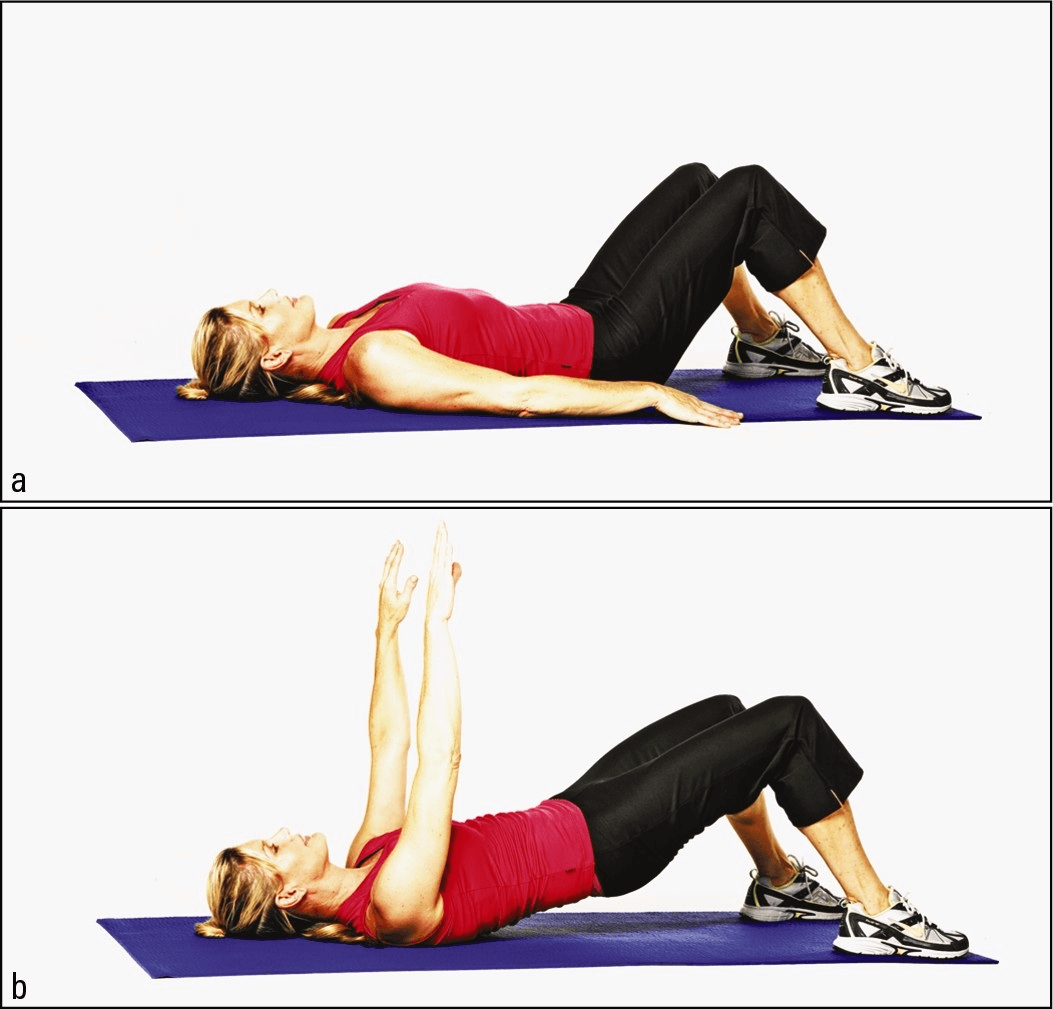
The lying pelvic tilts warm you up; this exercise focuses on loosening you up. To avoid stress on your lower back, use a smaller range of motion or don’t lift your hips too high off the ground.
To do this exercise, follow these steps:
1. Lie flat on your back, keeping your knees bent and tight together, your feet flat on the floor, and your arms at your sides.
Keeping your spine neutral, pull your bellybutton in toward your spine
2. Raise your arms straight up and slowly lift your hips toward the ceiling, allowing your butt and lower back to lift off the floor; hold for three to five seconds.
3. Slowly lower your hips back down, allowing your back to return to neutral position and keeping your knees pressed tight. Lower your arms.
4. Repeat ten times.
Both these hip lifts and the earlier pelvic tilts are important to help hold your lower body stable on the backswing and rotate your lower body toward the target on the downswing.
3. Crunches
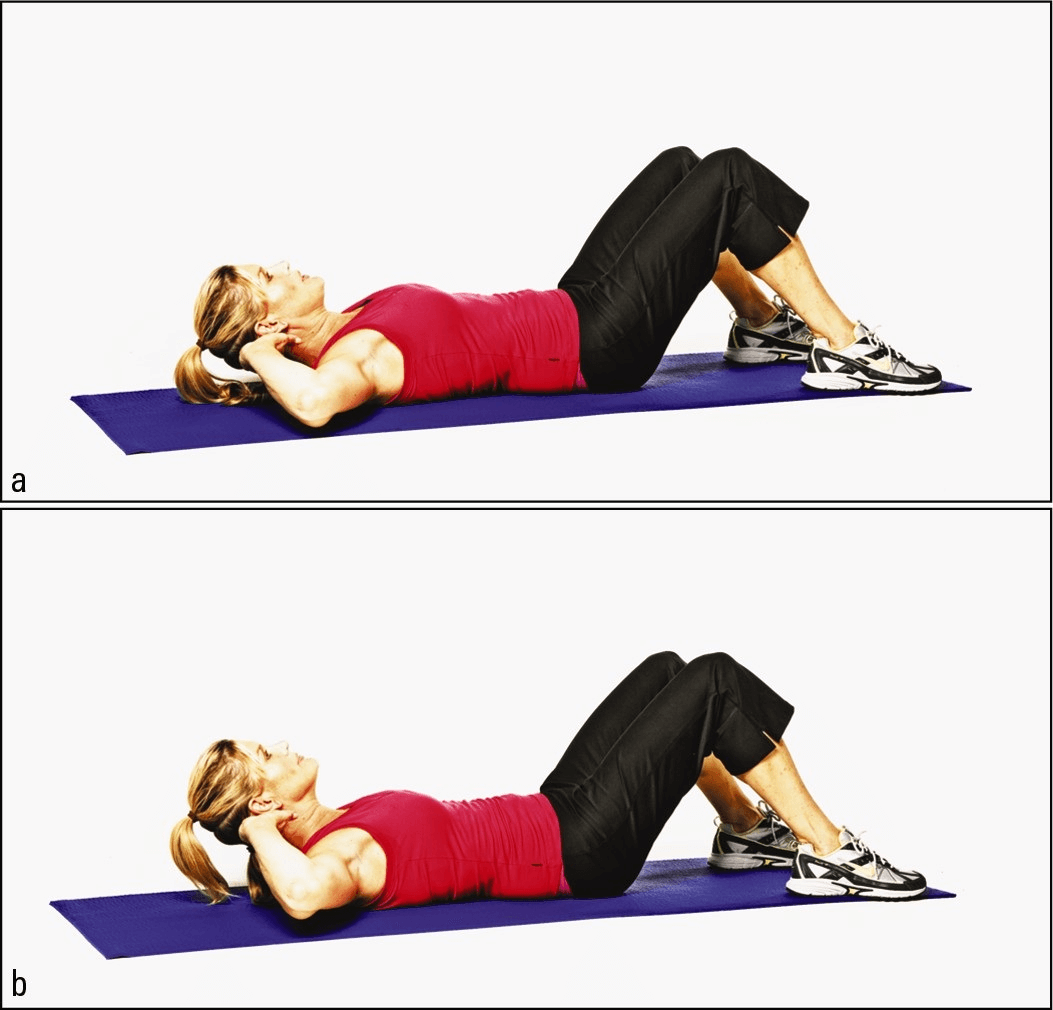
The simplest way to gain strength in your core and endurance is to do crunches. However, be sure to progress slowly. When you first try this exercise, place your fingertips behind your ears and your elbows bent and out to the sides.
Then you can try crossing your arms in front of your chest, which adds extra weight and a degree of difficulty to this exercise.
1. Lie on your back with your knees bent and fingertips behind your neck for support. Your feet should be flat on the ground. Be sure to keep a space between your chin and chest as you’re looking up toward the ceiling.
2. Raise your chest until your shoulder blades lift off the floor
3. Slowly lower back to the floor.
4. Repeat five to ten times, gradually progressing to more repetitions when you feel comfortable.
If the preceding crunch proves to be too difficult, try placing your hands palm down on the floor right next to your hips. Slide your fingertips about 3 inches toward your feet by using your abdominals to lift your shoulders off the ground. Hold briefly and then return to the starting position.
4. Side crunch
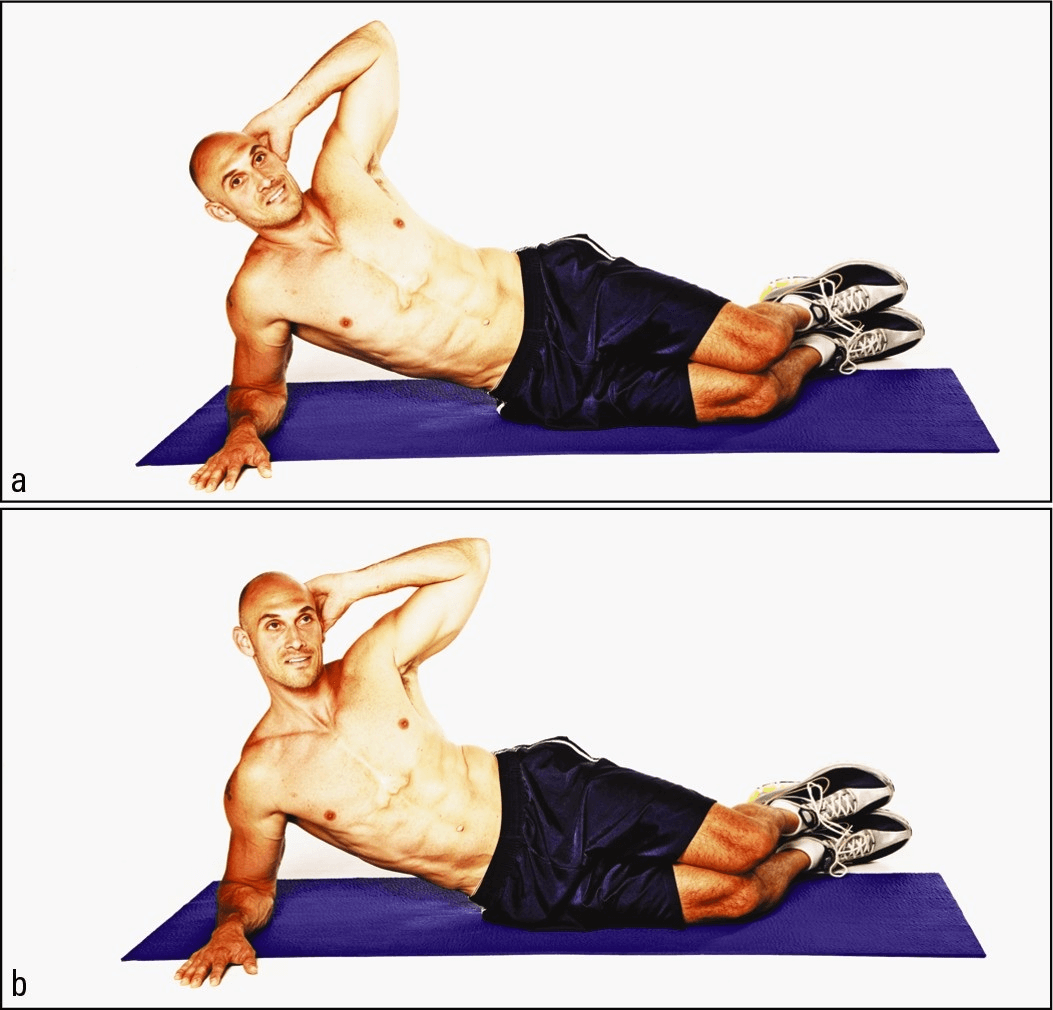
The side lying crunch is a great addition to your abdominal workout because it also helps target the side muscles or obliques. It can feel a bit awkward at first, but try it a few times; after you get the hang of it, you’ll see a smaller waist along with a stronger core!
To do this exercise, follow these steps:
1. Lying on the floor or on a mat, bend your knees and place your free hand behind your neck.
2. Lifting your upper torso, raise yourself slightly off the floor by using your waist muscles or obliques. Bring your elbow toward your feet to target the waist.
3. Return to the floor; repeat the exercise ten times and then switch sides.
5. Side planks
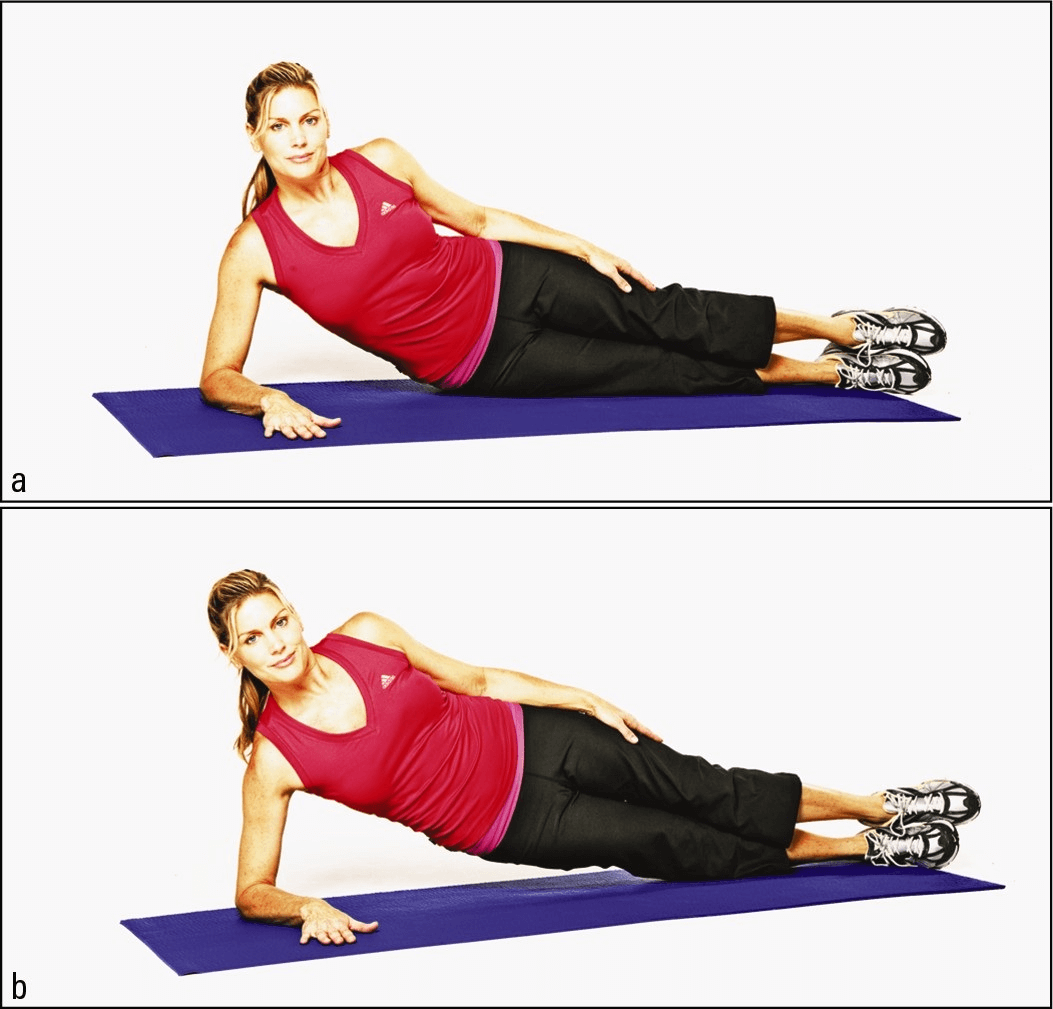
The side plank strengthens your obliques. This beginner’s version has you using bent knees rather than having your legs straight out to support your body weight — you can always work up to that more difficult position as you gain strength in your core.
To perform a side plank, follow these steps:
1. Lie on your left side, propping up your body on your left elbow; place your elbow directly beneath your shoulder.
Bend both of your knees at a 90-degree angle, stacking your thighs on top of each other. Place your right hand on the floor in front of your body for support. Ensure that your body is in a straight line from your head to your knees (or your toes if you’re doing the more advanced version) with a neutral spine.
2. Lift your hips so your torso comes off the ground and your body is in a straight line from your head to your knees (or toes).
If you can, take your right hand off the floor and place it alongside your body. Try to hold this position for 15 to 30 seconds
3. Repeat for three repetitions and increase reps as the exercise becomes easier.
6. Bicycles
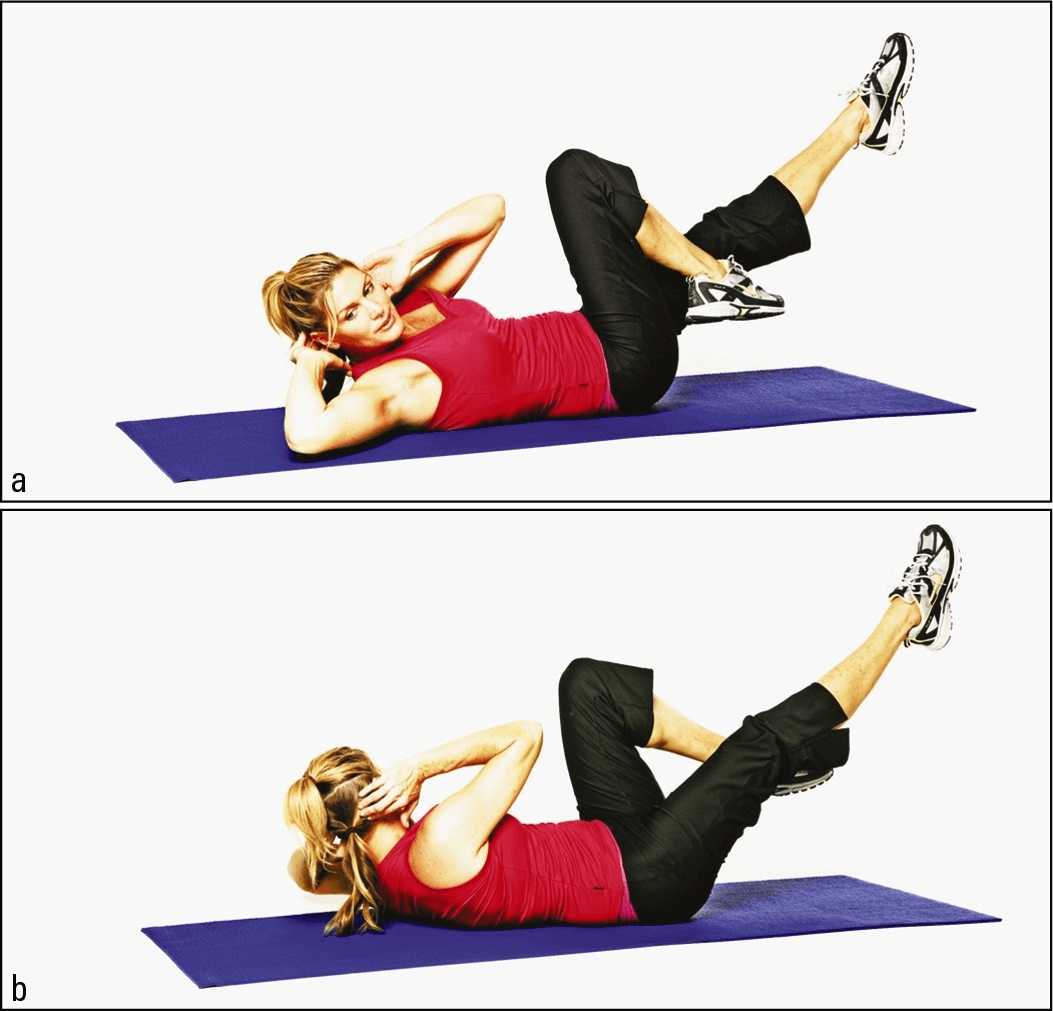
Hands down, this exercise is the best core exercise for targeting the waist, obliques, and abs. The twisting and pulling motion you do with your knees and upper body is perfect for getting your core in shape fast!
All core abdominal exercises help create stability and strength throughout your golf swing. Weak abdominals typically lead you to rely too heavily on your arms for your swing, dramatically reducing clubhead speed and centeredness of impact.
To do this exercise, follow these steps:
1. Lie on your back with your knees bent, your thighs perpendicular to the floor, and your fingers just behind your ears.
2. Lift your shoulders off the floor as you straighten your left leg; bring your right knee in toward your left armpit.
3. Without relaxing your torso or returning your shoulders to the floor, repeat the exercise on the other side by straightening your right leg and pulling your left knee in toward your right armpit.
Alternate the legs in a slow bicycling movement.
4. Repeat 15 times on each side.
7. Push-ups on knees
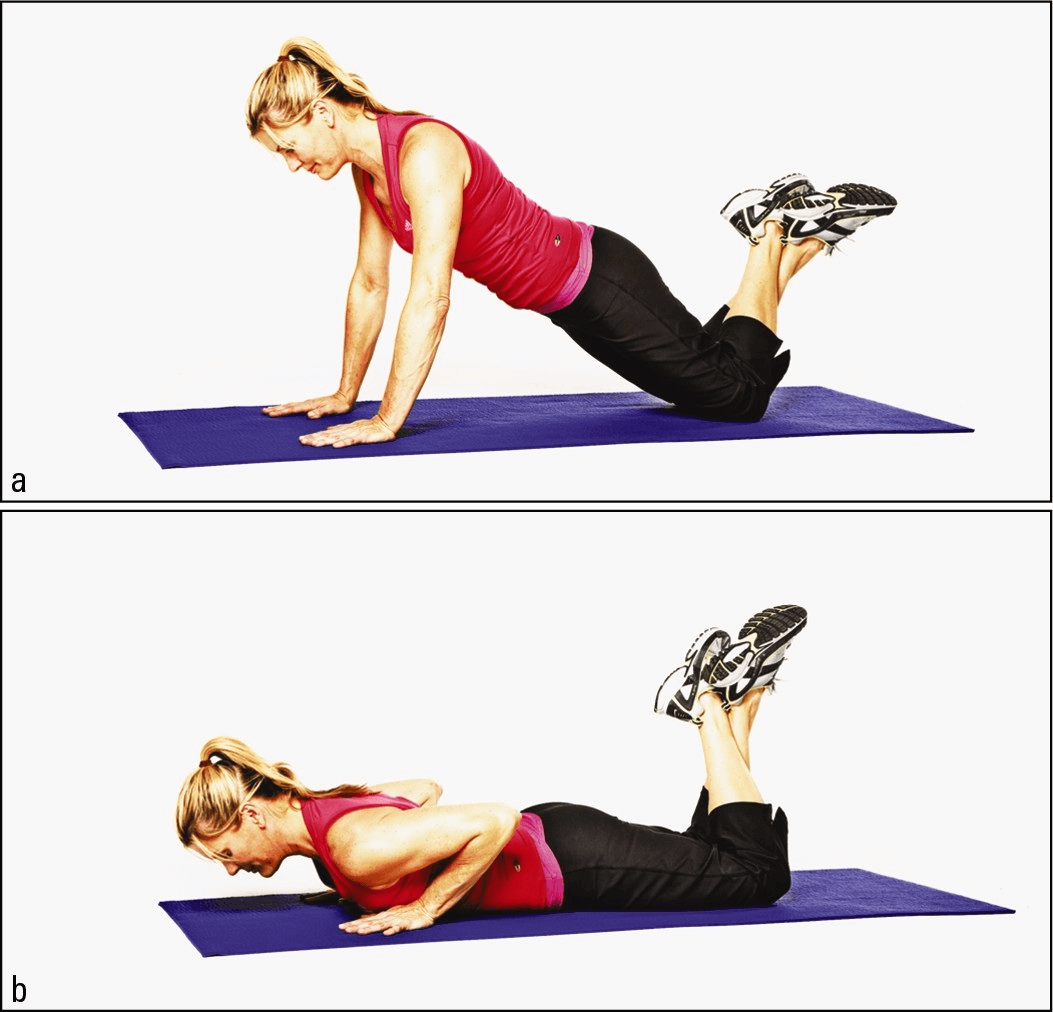
You may be wondering what push-ups have to do with your core. After all, haven’t you always been told to do push-ups to tone your upper body?
Although push-ups have traditionally been the go-to exercise for upper-body toning, push-ups on your knees are a good way to strengthen your belly and core area.
When you do a push-up, you recruit your core muscles to help keep your back straight and assist you in pulling your bellybutton in toward your spine.
You can progress to push-ups on your toes as you get stronger; however, always keep in mind that your back should remain straight and shouldn’t buckle from the weight of your body, even when supported by your knees.
Keeping your knees on the ground with a towel beneath them eases the harshness of the floor and provides better support for your body.
To do this exercise, follow these steps:
1. Kneel and place your hands on the floor in front of you, shoulder width apart.
Make sure that your hands are directly below your shoulders.
2. Lower your upper body toward the floor, bending your elbows out to the side.
3. Straighten your elbows and exhale as you press back up into the starting position.
4. Complete ten repetitions.
You can increase the number of repetitions as the exercise becomes easier.
8. Back extensions

This seemingly simple exercise is a powerful and effective back strengthener. It also targets the lower back, so if you have lower- back problems, you may want to skip this exercise.
To do this exercise, follow these steps:
1. Using a mat or towel, lie on your stomach and place your arms
at your sides with the palms facing up.
2. Pulling in or contracting your abdominal muscles, lift your chest a few inches off the floor without cocking your head back
3. Hold for a few seconds before lowering your chest back toward the ground.
4. Repeat this exercise three to five times.
You can increase the number of reps as the exercise becomes easier.
9. Plank

The plank is another top core exercise that targets the abdominals and back muscles. Stay strong and lifted during this exercise and maintain a long, straight back. Strong back muscles lead to correct posture and alignment on the course and off.
If your back is weak, you’ll have trouble maintaining the correct posture through your swing.
To do this exercise, follow these steps:
1. Lie face down, resting your forearms flat on the floor and keeping your elbows directly below your shoulders. Your feet should be no more than an inch apart
2. Lift your body off the floor by using your forearms and toes, keeping your body as straight as possible.
Maintain this position for as long as possible, and challenge yourself as you build up to longer periods in the plank position. Shoot for 10 to 15 seconds in the plank as you’re getting started.
10. Downward belly burners

Downward belly burners can improve your core muscle strength, promote your ability to achieve and maintain an optimal spine angle at address and throughout your full swing, and provide significant increases in swing speed that translate into increased power.
Follow these steps to take on this exercise:
1. Kneel on a padded surface and rest both forearms on an exercise ball. Keep your back straight enough that a golf club can touch your lower back, upper back, and the back of your head.
2. Keeping your pelvis stable and with a natural curve of the lower spine, exhale and slowly roll the ball forward, extending your hips and shoulders equally as far as possible until you feel a strong but comfortable abdominal, chest, and shoulder muscle contraction.
3. Inhale as you slowly roll the ball and pull your body back to the starting position.
Do one to three sets of 10 to 15 repetitions one to three times per day.
11. Superman

The superman drill improves your core strength, posture, and balance control, and strengthens your upper back and shoulders. It also improves your ability to maintain a proper spine angle, to stay balanced over the golf ball, and to make a consistent, full swing.
To perform this exercise,
1. Lie face down over an exercise ball and do a neutral pelvic tilt while holding a club in the tray position.
2. Maintain the pelvic tilt and then retract your shoulder blades together and reach your arms over your head with your elbows as straight as possible; hold this position for one breath and then bring your arms back to the tray position.
Do 10 to 30 repetitions of this exercise one to three times a day. When you’ve mastered it, increase the difficulty by holding hand weights rather than the club.
12. Russian twists
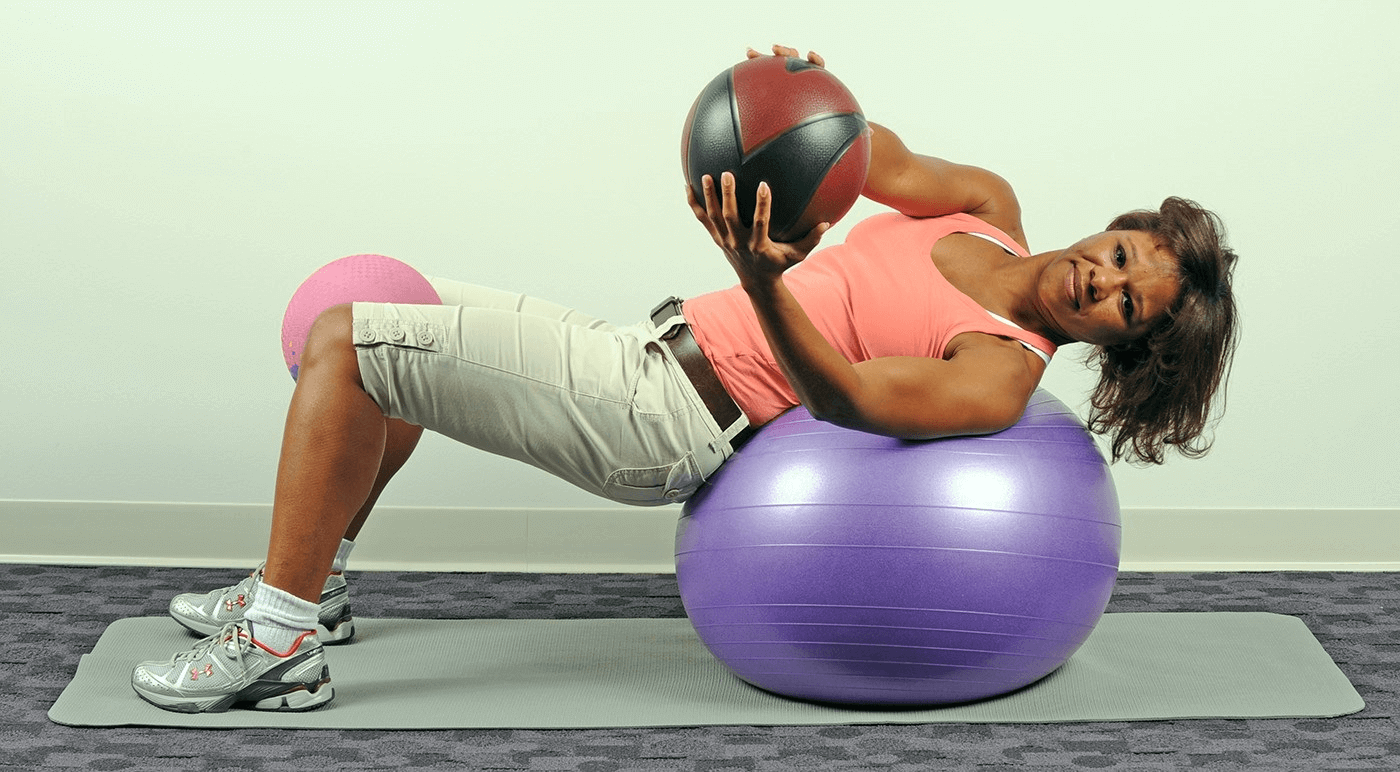
Russian twists improve your upper and oblique abdominal muscle strength. They also help you fully turn your shoulders without turning your lower body, which improves your swing speed and your power and distance off the tee.
To perform this exercise,
1. Lie on your back over an exercise ball with a soccer ball, volleyball, or kickball between your knees.
2. Hold a weighted medicine ball in your hands with your arms pointed straight up from your chest toward the ceiling.
3. As you exhale, slowly rotate your upper torso as far as possible in one direction, keeping your arms in front of your chest.
Then slowly rotate your upper torso as far as possible in theopposite direction. Do one to three sets of 10 to 15 repetitionsone to three times a day. When you’re ready to advance, increase the weight of the medicine ball and/or the speed of your upper body rolls.
13. Seated torso rotations
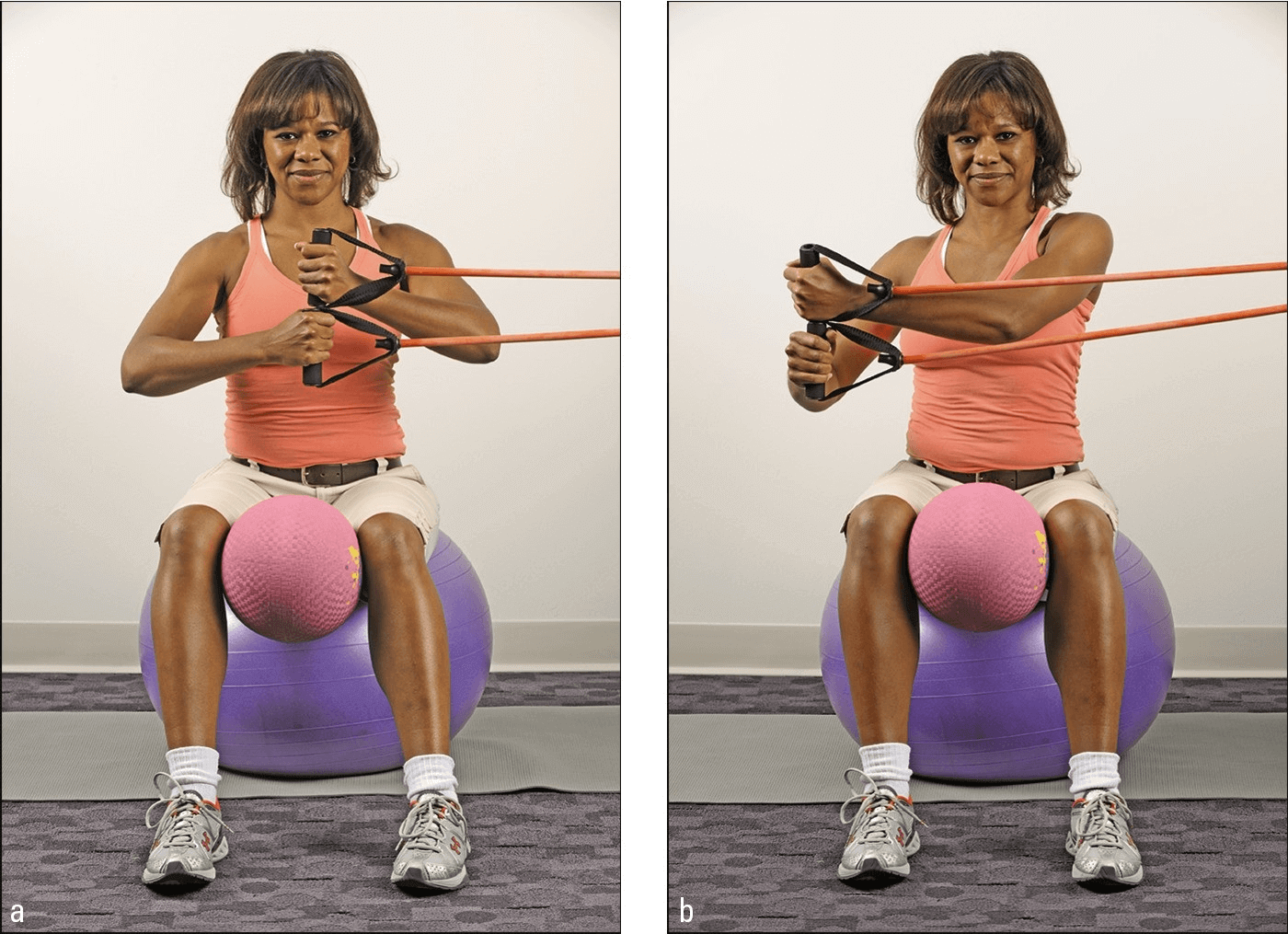
Seated torso rotations can improve your posture, balance, and core muscle strength. They can help you make a more complete shoulder turn in your full swing and improve your ability to maintain arm and club connection in front of your body throughout the full swing.
Equally important, they can reduce stress and injury potential to your neck, shoulders, arms, and lower back when you play golf.
Here’s how they work:
1. Attach fitness tubing with handles around a fixed pole (or in a closed door) and position an exercise ball so the tubing is at chest height as you sit on the ball, with no slack in the tubing.
You want the tubing at an approximately 30-to 45-degree angle to your left. Make sure your exercise ball is inflated so your hips and knees are bent to 90 degrees when you sit on it.
2. Hold both handles of the tubing with your arms pulled to the center of your chest.
3. Sit tall and perform a neutral pelvic tilt, squeezing your shoulder blades together and, as you exhale, slowly rotating your upper torso as far as possible to the right.
4. Hold this rotated position for one breath and then inhale as you relax your upper torso back to the starting position.
Perform one to three sets of 10 to 15 repetitions in both directions one to three times per day. When you’re ready to do more, stretch the tubing farther to add stretch resistance to the tubing, or invest in tubing with greater resistance.
As you gain flexibility, you can advance this exercise by extending your arms in front of your chest at the end of your full shoulder turn. You can also perform the exercise while standing.
14. Bow-and-arrow twister

The bow-and-arrow twister can improve the strength of your core, hips, chest, shoulders, arms, hands, and spine-rotation muscles, as well as your ability to maintain a proper spine angle during your swing.
It can also help you make a more powerful shoulder turn during your backswing and follow-through while reducing muscle stress and the risk of injury.
To perform this exercise, follow these steps:
1. Attach fitness tubing with handles in a low position around a fixed pole (or in a closed door) and stand in your golf address position with your hands in front of your body so the tubing angles up approximately 45 to 60 degrees with no slack.
2. Slowly pull one hand toward your body, rotating your spine and shoulders as far as possible while keeping your hips and legs stable
You should feel like you’re pulling the string back on a bow to shoot an arrow. Hold this position for one breath and then inhaleshoot an arrow. Hold this position for one breath and then inhale as you relax back to your starting position.
Do one to three sets of 10 to 15 repetitions in both directions one to three times a day. To add difficulty, stretch the tubing farther, or invest in more-resistant tubing.
15. Medicine ball twists

Medicine ball twists can improve your core and spinal-rotation strength as well as your posture and balance control.
They can also strengthen your arms, shoulders, hips, and legs and improve your ability to maintain a proper spine angle, which creates greater stability over the ball and a more consistent swing path.
They can even help you add clubhead speed for more distance.
To try this exercise, check out the following steps:
1. Assume your normal posture at address while holding a weighted medicine ball.
2. Perform a neutral pelvic tilt and shoulder-blade squeeze and slowly rotate your spine and torso to the right, keeping the medicine ball in front of your chest throughout the full turn.
3. Hold this fully rotated position for one breath and then slowly rotate as far as you can to the left.
Perform 10 to 30 repetitions one to three times per day. When you’re ready to do more, gradually increase the weight of the medicine ball. Other ways to advance this exercise are to:
- Increase the speed of your torso rotations.• Increase the speed of your torso rotations.
- Stand on half-foam rolls or any other unstable base — but be sure you maintain a stable lower body.



